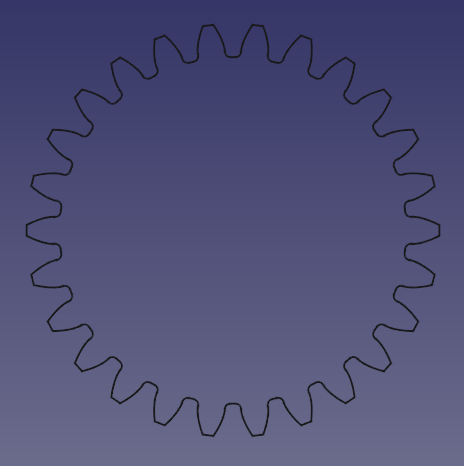PartDesign InvoluteGear/ru: Difference between revisions
No edit summary |
No edit summary |
||
| Line 2: | Line 2: | ||
{{Docnav/ru |
{{Docnav/ru |
||
|[[PartDesign_Sprocket/ru| |
|[[PartDesign_Sprocket/ru|Цепное колесо (звёздочка)]] |
||
|[[PartDesign_WizardShaft/ru|Мастер проектирования вала]] |
|[[PartDesign_WizardShaft/ru|Мастер проектирования вала]] |
||
|[[PartDesign_Workbench/ru|Верстак PartDesign]] |
|[[PartDesign_Workbench/ru|Верстак PartDesign]] |
||
Revision as of 18:07, 3 September 2022
|
|
| Системное название |
|---|
| PartDesign_InvoluteGear |
| Расположение в меню |
| Part Design → Шестерня с эвольвентным профилем... |
| Верстаки |
| PartDesign |
| Быстрые клавиши |
| Нет |
| Представлено в версии |
| - |
| См. также |
| FCGear Workbench |
Описание
Инструмент позволяет создать двумерный профиль эвольвентного зубчатого колеса (шестерни). Этот профиль полностью параметрический настраиваемый, и может быть преобразован в твердое тело с помощью выдавливания или инструмента Аддитивная спираль.
For more detailed information see Wikipedia's entries for: Gear and Involute Gear
Применение
Создание профиля
- Optionally activate the correct body.
- Go to the menu Part Design →
Involute gear....
- Set the Involute parameters.
- Click OK.
- If there was no active body: drag and drop the gear into a body for the application of further features like padding.
Формирование зубчатого колеса из профиля
- Select the gear profile in the Tree view.
- Press the
PartDesign Pad button.
- Set the pad's ДанныеLength to the desired face width of the gear.
- Click OK
Создание косозубого зубчатого колеса
- Select the gear profile in the Tree view.
- Press the
PartDesign AdditiveHelix button.
- Choose as Axis the normal of the gear profile, that is Normal sketch axis introduced in version 0.20. (In earlier versions the Base Z axis can be used as long as the profile's plane has not been altered.)
- Choose a Height-Turns mode.
- Set the ДанныеHeight to the desired face width of the gear.
- To set the desired helical angle an Expression for the ДанныеTurns is required.
- Click the blue
icon at the right of the input field.
- Enter the following formula:
Height * tan(25°) / (InvoluteGear.NumberOfTeeth * InvoluteGear.Modules * pi), where25°is an example for the desired helical angle (also known as beta-value) andInvoluteGearis the ДанныеName of the profile. - Click OK to close the formula editor.
- Click the blue
- Click OK to close the task panel.
Hint: To make the helical angle an accessible parameter, use a dynamic property:
- Select the profile.
- In the Property editor activate the Show all option in the context menu.
- Again in the context menu, select Add Property. Note: this entry is only available when Show all is active.
- In the Add Property dialog:
- Choose
App::PropertyAngleas Type. - Set
Gearas Group. - Set
HelicalAngleas Name (without a space). - Click OK
- Choose
- Now a new property ДанныеHelical Angle (space added automatically), with an initial value of
0.0°, becomes available. - Assign the desired helical angle to the new property.
- In the formula of the ДанныеTurns property of the AdditiveHelix, you can now reference
InvoluteGear.HelicalAngleinstead of the hard coded value of e.g.25°; again assumingInvoluteGearis the ДанныеName of the profile.
Свойства
- ДанныеExternal Gear: Внешнее зацепление - Да или Нет
- ДанныеHigh Precision: Высокая точность - Да или Нет
- ДанныеModules: Модуль - Диаметр делительной окружности, деленный на количество зубцов.
- ДанныеNumber Of Teeth: Задает количество зубьев.
- ДанныеPressure Angle: Acute angle between the line of action and a normal to the line connecting the gear centers. Default is 20 degrees. (More info)
Ограничения
- It is currently not possible to adjust the tooth thickness. Tooth and tooth space are distributed equally on the pitch circle. Thus the only way to control backlash is to adjust the center distance in a gear paring.
- There is currently no undercut in the generated gear profile. That means gears with a low number of teeth can interfere with the teeth of the mating gear. The lower limit depends on the ДанныеPressure Angle and is around 17 teeth for 20° and 32 for 14.5°. Most practical applications tolerate a missing undercut for gears a little smaller than this theoretical limit though.
Материалы для изучения
Сопутствующая информация
PartDesign 
- Инструменты структуры: Part, Group
- Вспомогательные инструменты: Create body, Create sketch, Edit sketch, Map sketch to face
- Инструменты моделирования
- Инструменты данных: Create a datum point, Create a datum line, Create a datum plane, Create a local coordinate system, Create a shape binder, Create a clone
- Аддитивные инструменты: Pad, Revolution, Additive loft, Additive pipe, Additive box, Additive cone, Additive cylinder, Additive ellipsoid, Additive prism, Additive sphere, Additive torus, Additive wedge
- Субстрактивные инструменты: Pocket, Hole, Groove, Subtractive loft, Subtractive pipe, Subtractive box, Subtractive cone, Subtractive cylinder, Subtractive ellipsoid, Subtractive prism, Subtractive sphere, Subtractive torus, Subtractive wedge
- Инструменты трансформации: Mirrored, Linear Pattern, Polar Pattern, Create MultiTransform
- Отделочные инструменты: Fillet, Chamfer, Draft, Thickness
- Бинарные: Boolean operation
- Дополнительно: Migrate, Shaft design wizard, Involute gear
- Инструменты контекстного меню: Set tip, Move object to other body, Move object after other object
- Начинающим
- Установка: Загрузка, Windows, Linux, Mac, Дополнительных компонентов, Docker, AppImage, Ubuntu Snap
- Базовая: О FreeCAD, Интерфейс, Навигация мыши, Методы выделения, Имя объекта, Настройки, Верстаки, Структура документа, Свойства, Помоги FreeCAD, Пожертвования
- Помощь: Учебники, Видео учебники
- Верстаки: Std Base, Arch, Assembly, CAM, Draft, FEM, Inspection, Mesh, OpenSCAD, Part, PartDesign, Points, Reverse Engineering, Robot, Sketcher, Spreadsheet, Surface, TechDraw, Test Framework
